This basic poached whole chicken recipe is one of the easiest yet most rewarding and cost-effective nutritious foods you can make in your kitchen.
It promises a rich chicken broth, fall-of-the-bone tender meat, and a light stock you can use to make many delicious recipes.
You'll get flavorful, simple ingredients from one whole chicken and endless dinner ideas.
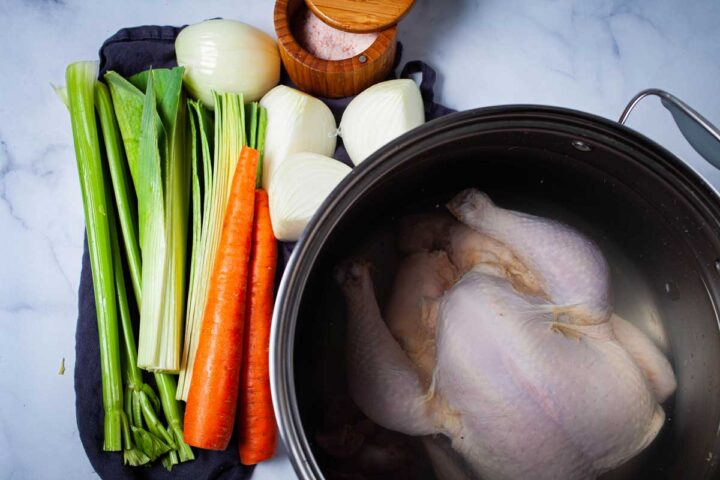
I will show you how to poach a whole chicken at home. It's easy to do and perfect if you are into meal prepping.
Make it on lazy (Sun)days. It will save you money and give you the tastiest ingredients to produce several healthy meals for the week or weeks ahead.
Jump to:
- Why You Should Poach a Whole Chicken
- Poaching Versus Boiling a Whole Chicken
- Choose a Whole Bird
- How Long Does It Take To Poach a Whole Chicken
- Should you remove chicken skin before cooking
- Elevate the flavors of your broth and shredded chicken
- What to do with chicken giblets
- How to poach a chicken
- How to shred the chicken meat
- What to do with the broth
- Note on skimming, straining the broth
- Also Recommended
- 📖 Recipe
Why You Should Poach a Whole Chicken
- Economical: It's one of the most economical ways to make nutritious food or prep your weekly meals.
- You get moist, tender, flavorful meat (poached shredded chicken): To enjoy in chicken salads, sandwiches, veggie dishes, chicken soups, and so much more.
- You get rich chicken broth to make a hearty soup, healthy gravy, or flavor other dishes.
- You'll have leftover stock. You can reuse the chicken bones and fatty skin and make another light stock to augment other dishes.
- It's a satisfying thing to make in your kitchen and only requires a bit of your attention occasionally while it simmers on the stove.
Poaching Versus Boiling a Whole Chicken
- If you want deliciously tender shredded chicken meat and deep, delicate chicken broth flavors, you must gently cook the chicken in liquid and below boiling point.
- First, bring the liquid to an initial boil or simmer on medium/high heat. But immediately lower the heat to maintain a slow and gentle bubble.
- If a chicken is boiled or cooked too quickly, it will toughen the meat and leave you with a flavorless broth. Slow and steady is the way to go here.
- The process is simple and requires little interference other than keeping an eye on your chicken and skimming off any extra fat or foam that comes to the surface.
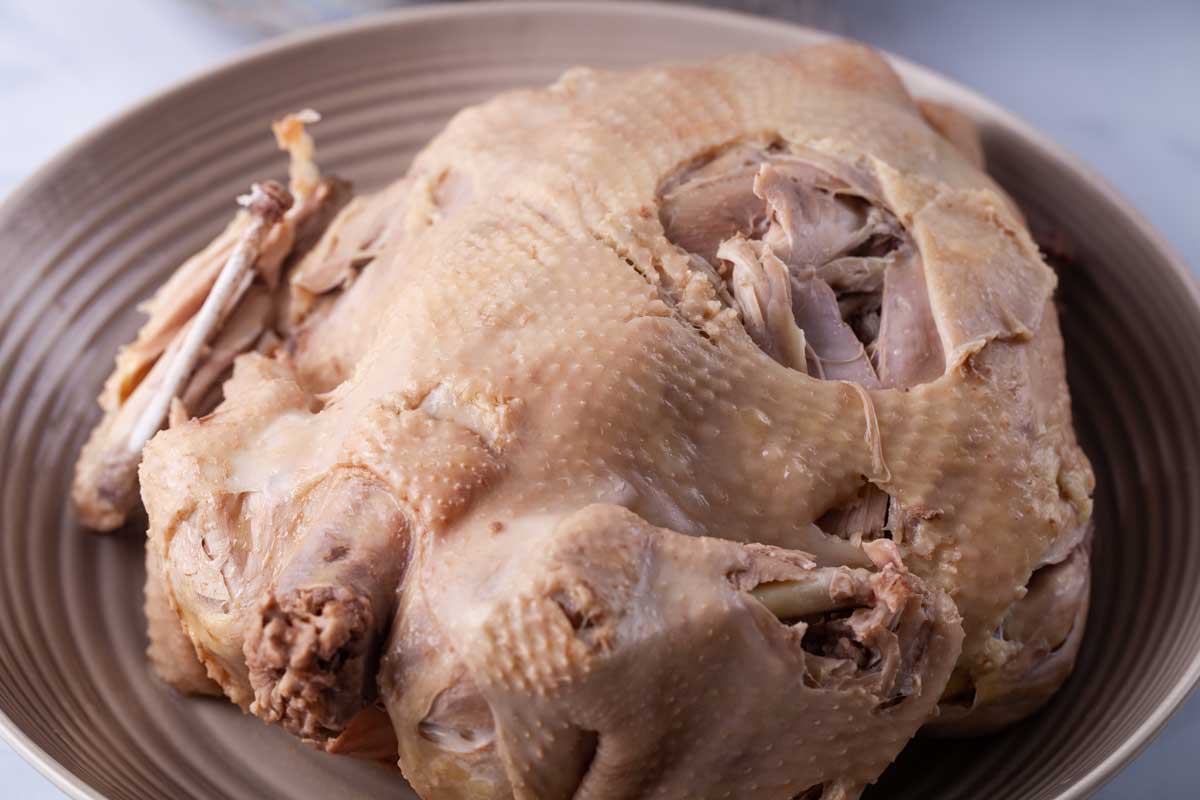
Choose a Whole Bird
- These days, most chickens come at a uniform of 3 to 3 ½ pounds.
- But if you can, get a 4 to almost five ½-pound one—I get them at my local farmer's market.
- A larger bird will yield more broth and meat for the same amount of work.
Since you are using the whole chicken from its bones to its tissues and fat, choose the best quality poultry you can afford—free-range and organic if possible. It plays a role in the taste of the broth and the meat.
How Long Does It Take To Poach a Whole Chicken
It, of course, depends on the size of the bird. Usually, it takes about 1 to 1 ½ hours, depending on the chicken's size. In general, count on about 15 minutes per pound of cooking time.
Should you remove chicken skin before cooking
Please don't.
It will give your collagen-rich broth a perfect balance of fat and flavor and prevent the meat from drying.
If you want a lighter broth, refrigerate it overnight. The fat will congeal on top, and you can skim it off before using it.
Elevate the flavors of your broth and shredded chicken
Salt—add at least salt to the poaching liquid. Sometimes adding nothing else but salt is preferred when using the collagen-rich broth and shredded chicken as a base in recipes where you want to control most of the flavoring when making the final dishes.
Add herbs or onions—Want to upgrade your broth so that enough flavors are present to enjoy immediately? Then add onions, a few garlic cloves, and herbs such as fresh rosemary or thyme. Those ingredients all add aromatic flavors perfect for making brothy soups or adding a bouillon-like flavor to cook rice and quinoa.
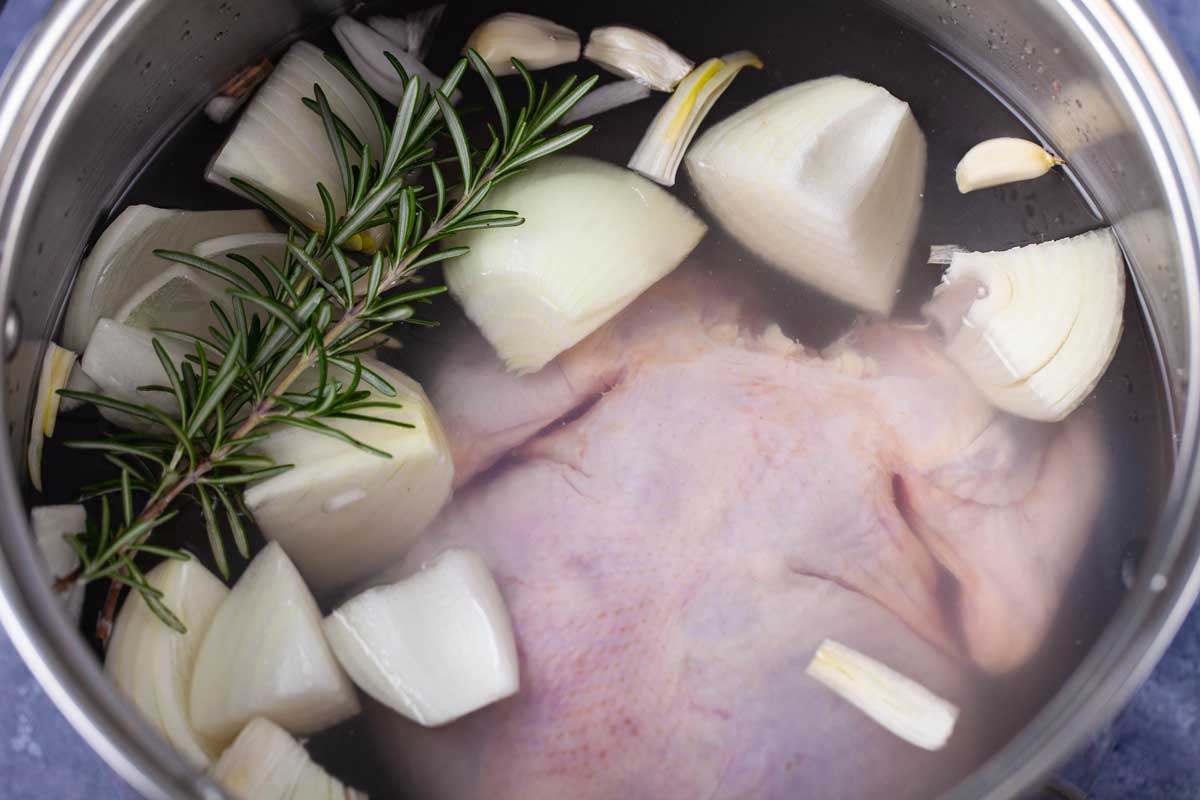
Add veggie scraps—The ends of carrots, leeks, onions, and even carrot leaves—all my favorites—can be added initially and then strained and removed afterward.
It's a great way to use vegetables for making a tastier broth without feeling too guilty about throwing them out before proceeding with fresh vegetable ingredients to finish your (chicken) soup or dish.
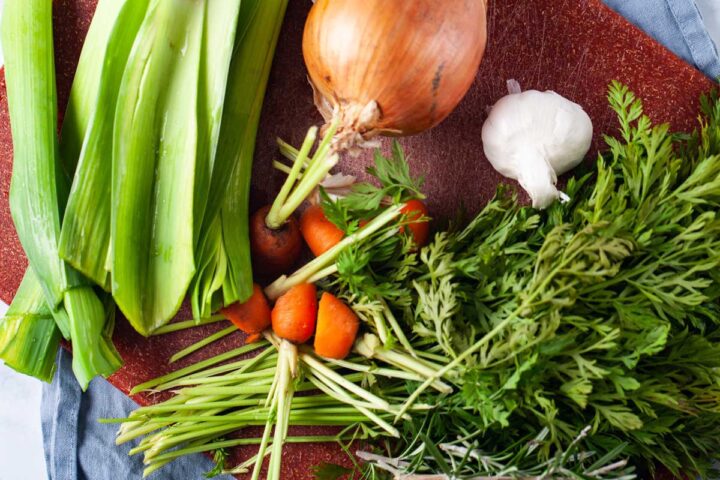
Add freshly chopped vegetables—You can always add newly chopped vegetables like carrots, onions, leeks, or celery from the beginning to give extra flavor. They're even tasty enough, in my opinion, to enjoy in a cup of broth that same day. But they might be too mushy and not bright enough for soup recipes. So I would eventually strain them, but it does add a lot of extra flavor to your broth.
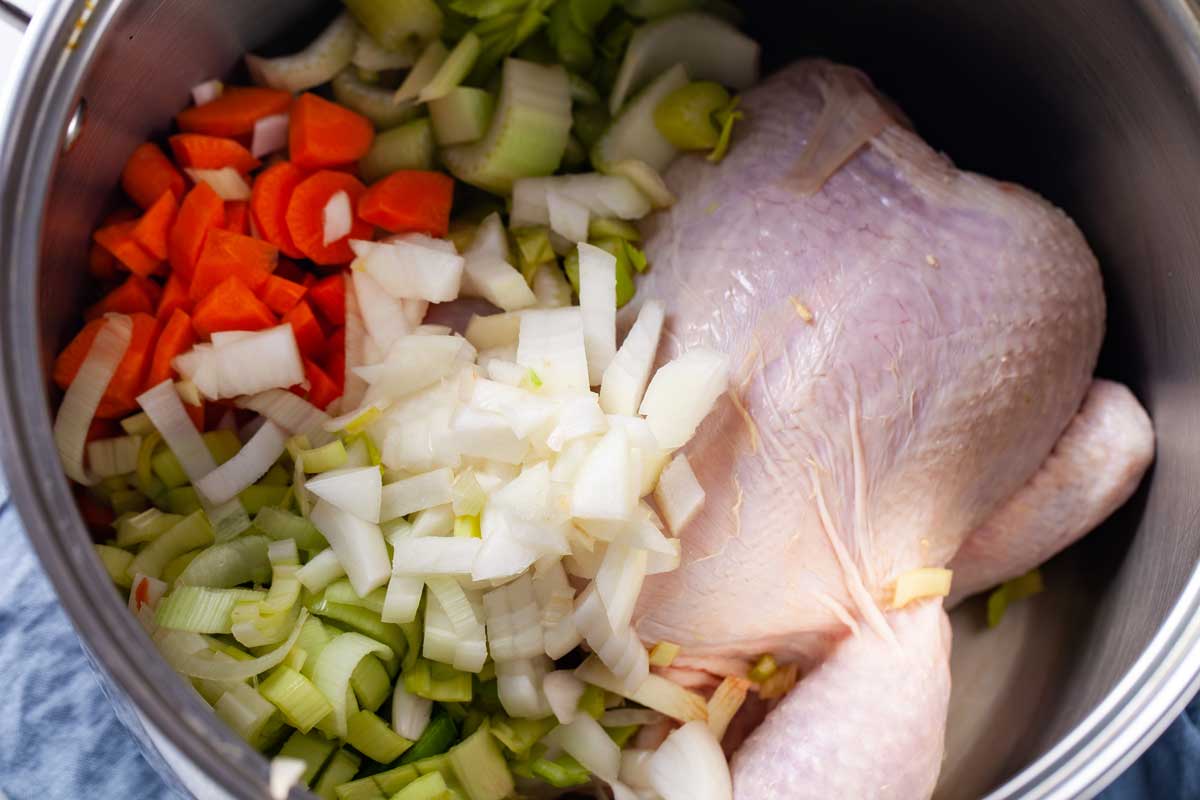
What to do with chicken giblets
Sometimes, you'll also get chicken giblets like the heart, neck, liver, and gizzards.
I add these to the pot, except for the liver—it has a distinctive taste that can overwhelm the flavors of the broth.
Note: Single out the liver, refrigerate to pan-fry later with garlic and onions to toss on top of your green salad for a quick lunch.
How to poach a chicken
It's easy. Just pay attention in the beginning. But once you have that slow tempo of bubbles coming up now and then, you can walk away doing other stuff while keeping tabs on time and checking in occasionally.
That slow bubble is key to getting that beautiful tender meat.
- Place the whole chicken and the giblets (except the liver) in a large, deep stockpot—the chicken has to fit in the pot comfortably.
- Add your chosen veggies, veggie scraps, and herbs.
- Add cold water, enough for the chicken to fully submerge with a depth of two inches.
- Flavor the water with salt.
- Heat the water over high heat, pot covered. I usually bring the water first to an initial boil or simmer.
- At the first signs of bubbling, reduce the heat until you can see the occasional bubble breaking through the water.
- Partly cover the pot and cook for about 60 to 90 minutes or until the chicken is fully cooked and the meat almost falls off the bone.
- Turn over the chicken at least once during the cooking process.
- Skim off any foam (protein scum) on the surface and discard.
- Check for doneness: stick a skewer into the joints where the drumstick meets the thigh. All the juices should run clear. If you use a thermometer, it's done when it reads at least 165°F/75°C.
How to shred the chicken meat
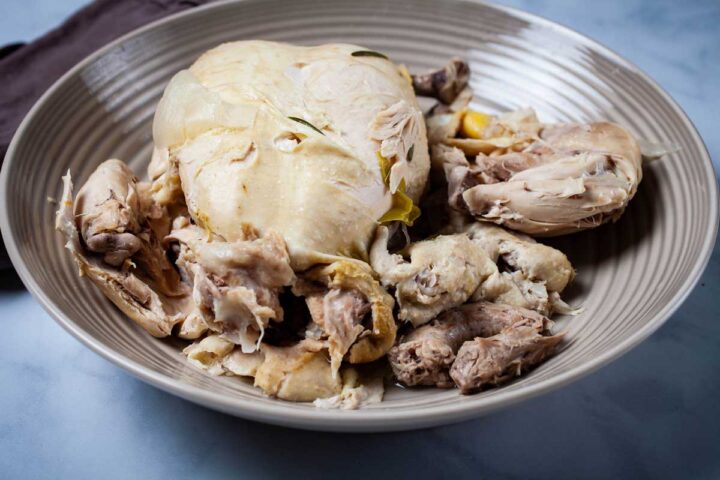
- Carefully remove the chicken. The whole chicken might break apart when transferring it from the pot to a plate, so be prepared with tongs in one hand and a large slotted spoon in the other.
- Allow it to cool down.
- When cool enough to handle, separate meat from the bones and skin with your fingers. You can use a fork to pull the meat apart into shredded chunks or use a knife to cut it into smaller pieces—whatever you prefer.
- Use immediately or store in an airtight container in the fridge for up to 3 or 4 days.
- A good portion of that shredded chicken can be used in chicken soup or tasty chicken salads, and you can refrigerate extras to fill up other dishes or make sandwiches.
Note: chicken bones and skin can be used again to make light chicken stock. But we love nibbling the little marrow out of the soft, easy-to-chew-cooked chicken bones—not a pretty sight but so good. So, there is never much left to flavor another chicken stock. But if you are not a bone nibbler, reuse the chicken bones and skin or discard them.
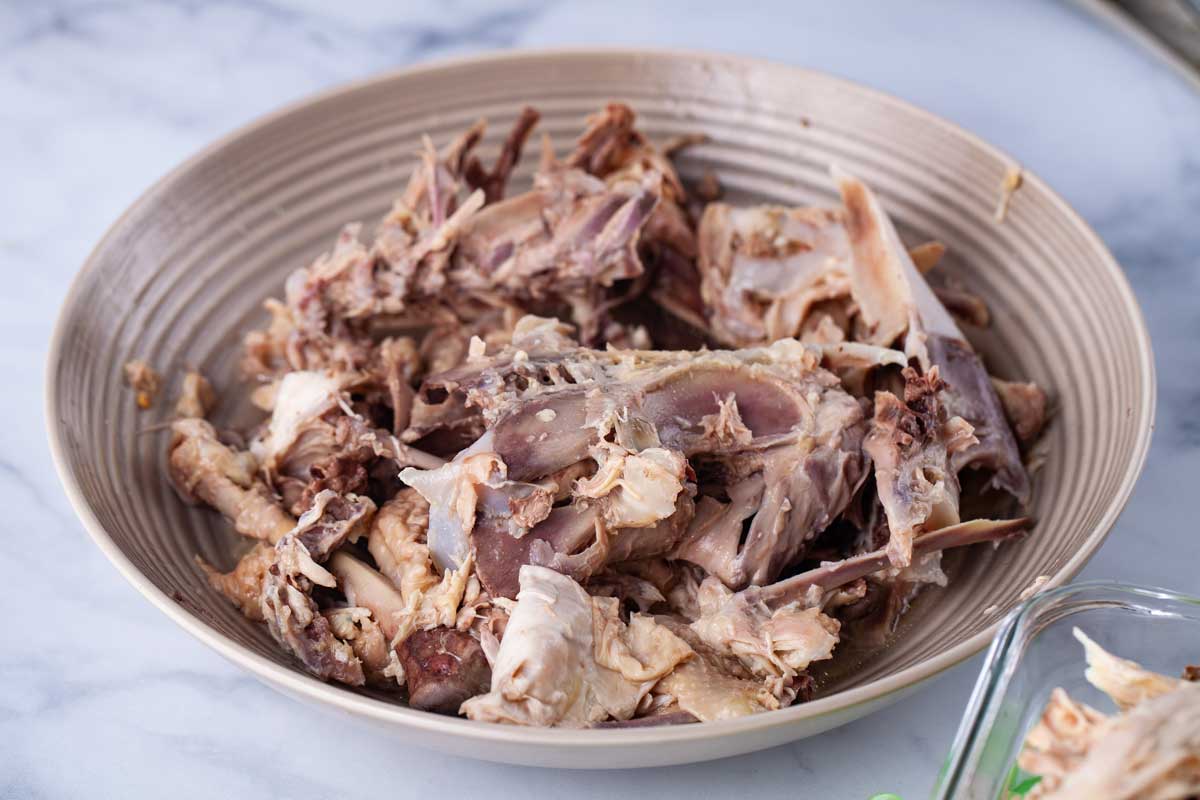
What to do with the broth
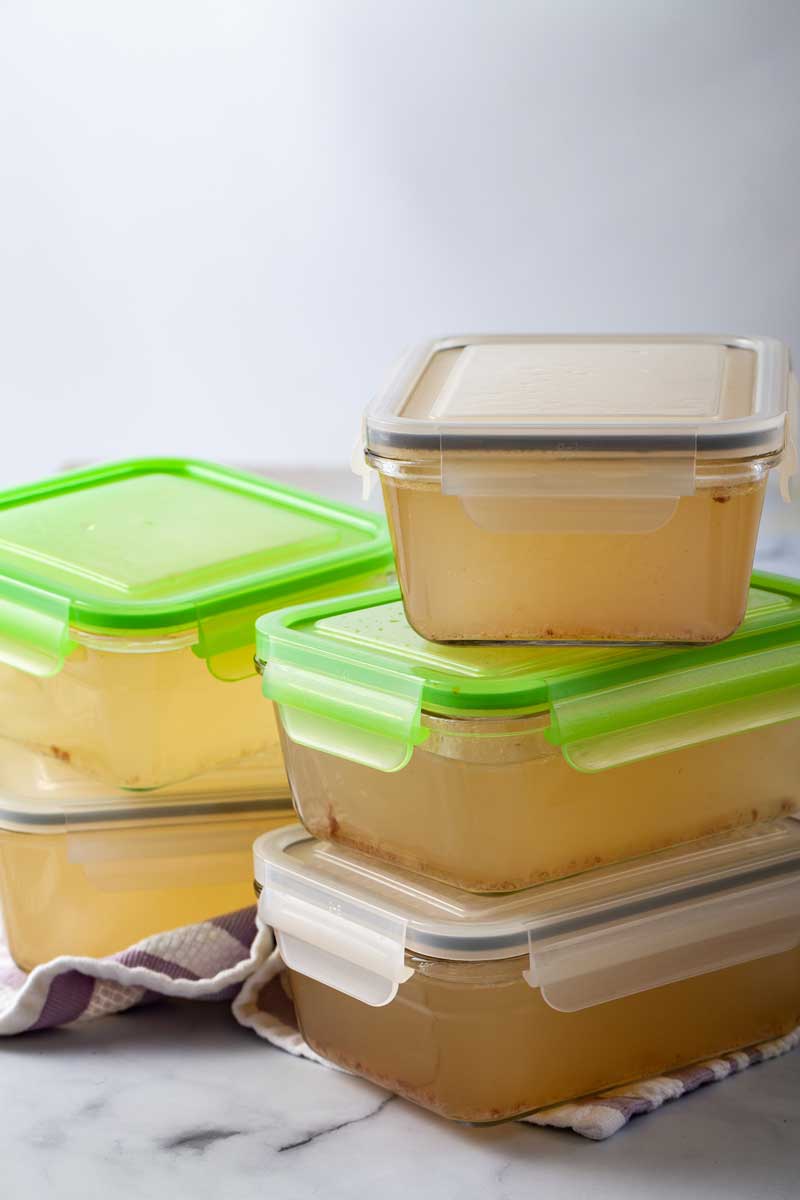
- Strain any veggie scraps or herbs used to flavor the chicken broth.
- You can turn the broth immediately into soup for dinner. That can often be as simple as a Straciatella, noodle, or chicken soup ( add freshly chopped vegetables (like carrots, onions, leeks, celery, or whatever the soup recipe calls for).
- If not immediately used, place the broth in individual-sized airtight containers, and store it in the refrigerator (up to 4 days) or freezer for later (up to 6 months).
- Once ready to use in a dish, spoon off the fat that has congealed on top and turned solid. I am not too picky about painstakingly removing any tiny chunks of it.
Check my 35 Easy Homemade Recipes Using Chicken Broth Or Stock.
Note on skimming, straining the broth
Sometimes a foam (solid proteins) rises to the top when slow-poaching a whole chicken.
I still have the habit—thank you, mom—of occasionally skimming it off with a ladle.
But I am not overly obsessed about it and am less concerned with an utterly perfect strain that might leave some of these bits of protein sink to the bottom, at least not for a (chicken) soup.
But if you want to get it clear, like a consomme type of stock, strain it before it is completely cooled.
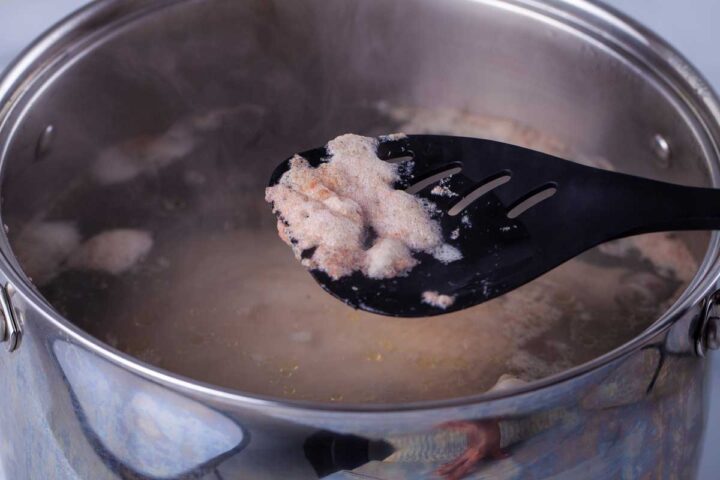
What's next? Try this easy and healthy chicken salad recipe to use up that shredded chicken, an Asian-inspired buckwheat noodle soup that can use some of this chicken broth, and make this delicious Stracciatella (or Italian egg drop) soup.
Also Recommended
Don't forget to subscribe to my Monthly Newsletter!
📖 Recipe

Tender Poached Whole Chicken
Mariska RamondinoIngredients
For the Broth
- 1 whole chicken 3 to 5 ½-pounds
- 1 tablespoon sea or kosher salt
- Water
- 1 yellow onion peeled and cut into large chunks
- 2 - 3 cloves of garlic peeled (optional)
- Fresh Rosemary or Thyme leaves
Add Vegetables or veggie scraps—optional
- ½ - 1 leek chopped
- 1 - 2 large carrots chopped
- 2 - 3 celery stalks chopped
Instructions
- First, check if the chicken doesn't have any giblets in the cavity. If so, remove it, and set it aside.
- Use paper towels to pat-dry the whole bird, including the cavity. Take the giblets out of the small bag and pat-dry as well.
- Place the whole chicken and the giblets (except liver) in a large, deep stockpot—the chicken has to fit in the pot comfortably.
- If using, add either veggie scraps or freshly chopped vegetables and herbs like Rosemary or Thyme leaves, onions, carrots, leeks, and celery. I don't always add garlic, but that's an option too.
- Then add enough water to cover the whole chicken with a depth of two inches.
- Add one tablespoon of salt.
- Cover the pot and bring to a boil on medium/high heat. As soon as the water has come to a boil, immediately lower the heat to a very slow but steady simmer—a few bubbles should rise now and then steadily but gently. Then partly cover the pot.
- Cook for about 60 to 90 minutes or until the chicken is fully cooked and the meat almost falls off the bone. Turn over the chicken at least once during the cooking process.
- Now and then, you might see a froth (protein scum) coming up to the surface. Skim it off with a ladle and discard.
- When done and the chicken is very tender, use tongs (I also like to use a slotted spoon in the other hand to support the chicken from below) to transfer the whole chicken from the pot to a large bowl or shallow container. Cover and set aside until it's cool enough to handle.
- Strain the liquid through a sieve and discard any vegetables if used.
- You can use all or some of it to make a soup or reserve the broth for later.
- If you want to reserve it for later, transfer it to individual-sized airtight containers and allow it to cool first before storing it in the fridge or freezer.
- When the chicken is cool enough to handle, use your fingers to separate any chicken meat from bones and skin. Discard the bones and skin.
- Shred big pieces of meat with your hands into smaller chunks, or use a fork to pull the meat apart. Use the meat immediately to make a chicken salad or in sandwiches, or store it in airtight containers in the fridge for up to 3 or 4 days for later use.
Notes
- Giblets: I like to reserve the liver for another time, as it can add a distinctive livery flavor to the stock. You can refrigerate to pan-fry later with garlic and onions and toss on top of a green salad for a quick lunch.
- Straining the broth: If I use the broth immediately to make a chicken soup or Italian egg drop soup, I am less concerned with an utterly perfect strain. However, if you really want a clear stock and remove bits of protein that might have sunk to the bottom, then strain it before it is completely cooled using a fine sieve or a colander lined with cheesecloth.
- Refrigerate chicken broth for up to 3 days: After refrigeration, a thick layer of fat will have risen to the top of the broth. When ready to use it, always skim off the fat that has congealed on top.
- Freeze the broth in individual-sized airtight containers for later and up to 6 months.
- A 4 to 4 ½-pound chicken yields about 5 cups of shredded chicken meat and 16 cups of chicken broth.
- Chicken bones and skin: either discard or use it again to make a light stock. Place them back in a large stock pot and cover them with salted cold water. Bring to a gentle simmer and cook again for anywhere from 4 to 24 hours. You could use any veggie scraps again to add more flavor. Strain solids and cool broth. You could also make this in the slow cooker and follow the same process as this bone broth.
Add your own private notes
Whenever you come back to this recipe, you’ll be able to see your notes.
Nutrition (% Daily value)
Disclaimer: This nutritional data is calculated using third party tools and is only intended as a reference.


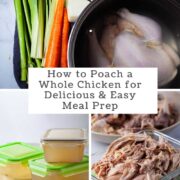
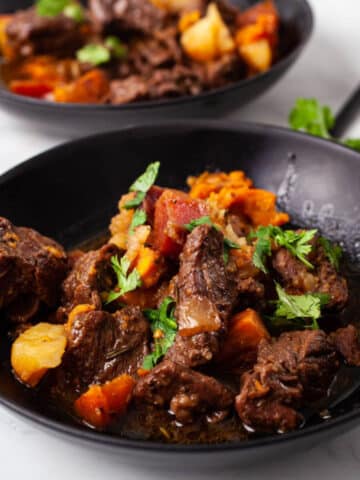
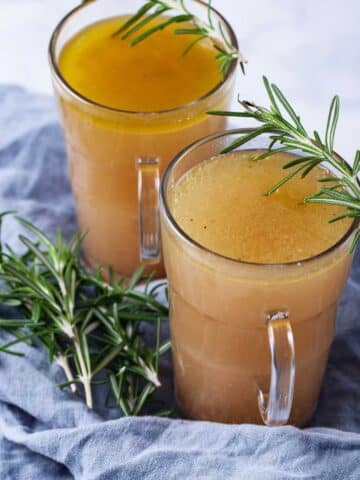


Greg Ragle says
Can't thank you enough for posting this. What a superb foundation recipe for such a plethora of great hot or cold dishes; great for variety not only in family meals, but also for people who live alone and all too often, do not take the time to prepare healthy meals.
Mariska Ramondino says
Dear Greg, thank you so much for stopping by and leaving a rating and such a nice comment. It's very much appreciated! And I am so happy you like this old family recipe. I still make it regularly;)"
Debra says
Yessss- it’s great!
I remember my grandma poaching chicken and how perfect it tasted right out of the pot!
Mariska Ramondino says
Thank you, Debra. This recipe reminds of my grandmother as well;)
Emma says
what type of cream do you use if you want to poach it in cream?
Mariska Ramondino says
Hi Emma, you can try a classic French cream sauce. Once the chicken is done, skinned, and carved, and the broth is strained, you can turn the broth immediately into a creamy soup for dinner, adding the shredded chicken and any freshly chopped veggies of your choice. Melt 2 tablespoons of butter over low heat. Whisk in 2 tablespoons of flour (ensure it doesn't brown). When sufficiently combined, gradually whisk in 1 cup of broth in which the chicken is cooked. Allow it to thicken while whisking rapidly. Then add about 1/2 to one cup of heavy cream. Let it come to a simmer—season with salt, freshly ground pepper, and juice of 1/2 lemon. Next, gradually stir in more of the stock mixture as desired and the desired amount of chicken. Cook, occasionally stirring, for 15 minutes or until soup thickens slightly over low to medium heat (don't let it come to a boil). Taste test and season with salt and pepper—maybe a sprinkle of parsley.
Lauren says
Looooove this recipe thank you so much! Will never do a roast chicken again. Mine made sooooo much broth that my freezer is still full, when I tasted one it was fairy mild so I will maybe add one more step next time and simmer the broth left at the end to halve it in volume but taste more concentrated, just to save on space! Thank you again 🙂
Mariska Ramondino says
Hi Lauren, you are so welcome, and I am so happy this family recipe worked out for you.
Marnie T says
Hi there, thanks for posting this. It's been awhile since I've poached a chicken and couldn't remember how long to cook it. I like the European veg and herbs you described, but I also learned of an Asian variation that uses jujube (red dates), several scallions, a whole head's worth of garlic cloves and a nub of ginger. Sometimes I stuff the cavity with ginseng and a handful of uncooked sticky rice (for Korean samgyetang). I don't add any salt until serving. It's great for recovering after sickness.
Mariska Ramondino says
Hi Marnie, so glad that I was able to help you out with the cooking time. And thank you for sharing an Asian variation—it sounds delicious too.
Val says
Five Stars! I would give it six if I could! I made it exactly as described with the veggies. The broth is wonderful, and the chicken definitely falls off the bone! I had an over 6 lb bird so I simmered it 90 minutes and that was plenty. Next time I will take about ten minutes off of the cook time. Soup tonight and lots of meals with shredded chicken for the week!!! So so good.
Mariska Ramondino says
Hi Val, I am so glad you tried it out and loved it. This poached chicken is one of my family's favorite as well! And thank you for the rating..it is so appreciated!
Barbara says
Hello, I am not sure how long this has been posted. I hope you still check it. I have a home grown huge chicken 7+ pounds that I want to poach. Have you ever poached one that large? And if you did, do you remember how long it took? thank you!
Mariska Ramondino says
Hi Barbara,
Thank you for stopping by. I'm properly jealous of your homegrown chicken;) I did poach a large one once, but it was a stewing hen that I got from the farmer's market. Their meat is a bit tougher and requires a bit more time. But in general, I would add about 15 minutes per pound to the average total cooking time. So, it would be about two to 2 1/2 hours. But, I would check from time to time, especially around the two-hour mark, because it also depends a bit on the toughness of the bird. If the chicken is almost falling apart, it's ready. Good luck!